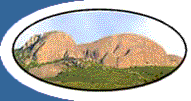A tall, wild order
2007-05-24
SHE is the most venomous lady alive, but her reputation is worse than her bite. Like most females, she is not dangerous unless provoked.
That’s according to Brian “Snake Bite Jones” Vorster, the reptile and birdman at the newly established Giraffe House wildlife awareness centre in Joostenburg.
And how does he know the Boomslang is a she? Because she is brown, that’s why. Her male partner would be green.
And yes, they are the most venomous of the 140 snake types in South Africa, and the more than 3000 types in the world.
This is just some of the many interesting titbits you will learn when you visit the centre, where scholars and tourists can appreciate African wildlife in the open.
Some of Brian’s reptiles and birds acted in the movies Racing Stripes and Sinbad the Sailor.
Apart from Bobby the Iguana, Cape vultures, Maribu storks, hornbills and parrots, Brian plans to have a specialised chameleon section and an African village as well as a “beautiful creature” zone with the likes of stone fish and leopard toads.
In South Africa five people die from snakebites each year, Brian says, while during the same period 38 people die of lightning strikes and 36 of human bites.
You have to believe him. He’s the expert, after all. So watch your step in the veld. The puffadder is a master of camouflage and extremely dangerous when you put your foot down on him.
Watching Brian handle the venomous cobra and Black Mamba, sends shivers down your spine.
A cobra bite can kill you within 20 minutes. The best way to handle him, is with a telephone pole, warns Brian.
Even if you try to stand still and stare him down, your legs will wobble. The cobra smells with his tongue and sees any movement.
He will however, not give chase, and a human can run faster than any snake - especially if you are afraid.
The Black Mamba is actually grey. The name is derived from the black inside of his mouth. Most feared in South Africa, the Black Mamba grows to 4,5 metres.
If you are brave, you could ask Brian to handle his armful of corn snakes, slithery but harmless. These very same snakes were used in the reality show, Fear Factor.
You could also ask to have one of his pythons wrapped around you.
Although still young, the pythons already weigh down a grown man.
But at least they do not weigh the 200kg their mature cousins would in the jungle.
When Brian closes the lid on his snakes, a sigh of relief is audible among the visitors.
Horace, the orphan barn owl who was hand-reared, is a much safer entertainer.
The owl has amazing hearing, with specially adapted ears and his white cheek patches acting as a satellite dish to track the slightest sound in total darkness.
Brian is very fond of his hand-reared Hadeda, although he admits his cries for help are screamed whenever the Vorsters want to sleep late.
It is because he is afraid of heights, Brian defends the piercing sound, and allows the bird to dig his long beak into his closed hand to retrieve a snack.
Then there is Mr Pelican, an eight-year-old pelican who with his keeper Martin Odd, is at home in shopping malls and entertainment centres around the country.
Oddly enough, Mr Penelican is afraid of water. It took months to coach him into murky water for a film shoot, but when he was supposed to perform his act, a fish swam in front of him and he fled.
Alison, the hand-raised Cape vulture, was taught to fly along with her dozen friends at the Joostenburg wildlife centre.
Much to the delight of the visitors, Alison now responds to Brian’s calls, hops along for a few steps, and then takes to the air to perch on a pedestal in front of her handler.
Unlike Nuschka, a Lanner falcon who perched on Brian’s hand at a demonstration. True to his predictions, Nuschka looked around, shook her feathers, went to the toilet, and flew into a tree.
She sat but a second, and then took to the skies. She reached a thermal and started gliding.
Falcons see a lure from a distance of 30km, and then drop out of the air at 300km/h. That day however, Brian needed to use a tracking device to fetch his wayward bird from a mountaintop eight kilometers away.
Apart from the novelty bird and snake section, there is a larger wild life area with enclosures to house the world’s tallest animal, the giraffe, some buffalo, hippopotami, zebra and monkeys.
The biggest antelope in the world, the eland, as well as the smallest, the blue duiker, have found residence at the Centre.
Just as the eland loses heat through extra flaps of skin, the gemsbok (oryx) has its own cooling system, with adapted blood vessels, perfect for the Boland’s scorching summers.
Open seven days a week, the entry fee is R28 (children R18) with special rates for group bookings. Phone 083-470-8488 for more information.
More
News
|


